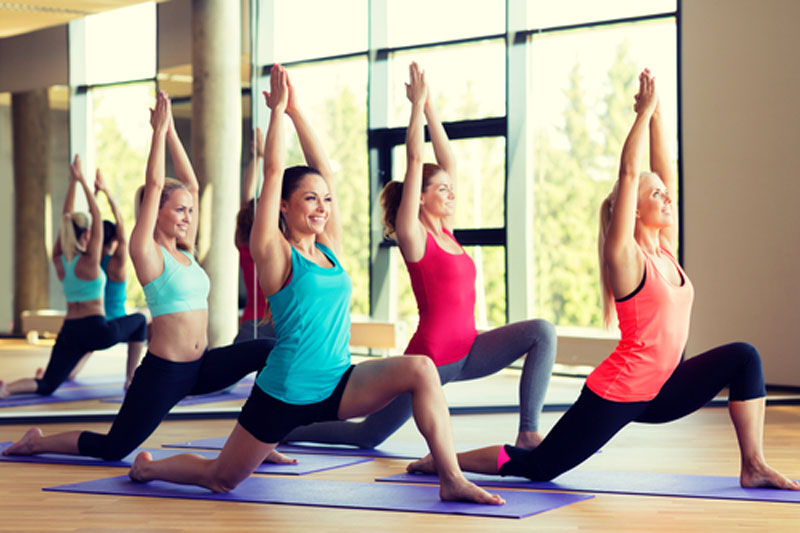Yoga Awareness Month: skin and exercise
Yoga might be thought of as good for the mind and physical fitness, but its benefits for the skin are rarely touted. Yoga is fantastic for the skin! Here’s why…
We spend a lot of time focusing on the effect that the sun and environment have on our skin, but few of us stop to think about the detrimental effects that our modern lifestyle and its stressors have on our appearance. Most of us are familiar with dark circles and puffy eyes and dull skin after a late night out, but more and more research is showing that the accumulation of stress hormones may have far-reaching skin implications.
Both lack of sleep and stress prompt our bodies to produce a hormone called cortisol, which causes blood sugar levels in our bodies to rise. This can lead to weight gain, heart problems, and diabetes. Recent research is shedding light on the connection between cortisol production, stress and lack of sleep—and the effect this has on our skin. The stress hormone cortisol increases blood sugar levels, but regular exercise, such as yoga practice, has been shown to reduce cortisol levels. Yoga has a meditative component that is particularly effective at lowering cortisol levels. Weight bearing exercise such as lifting weights can lower blood sugar levels by making tissues more sensitive to insulin. So weight lifting and yoga both have the ability to slow skin aging. For more, read on!
How Stress Causes Your Skin to Age
- The stress hormone known as cortisol causes blood sugar increases, which can accelerate the aging process, since excess sugar can compromise the collagen and elastin in our skin through a process known as glycation. Glycation can lead to wrinkles.
- Collagen and elastin are responsible for young skin’s strength, thickness and ability to bounce back. These proteins are found in the dermal layer of the skin known as the “dermis.” When collagen is damaged, skin becomes thin, wrinkled and fragile, while compromised elastin results in decreased elasticity that prevents skin from “bouncing back.” Damaged elastin is abnormally clumped together and nonfunctional when viewed under a microscope, and research has convincingly shown that glycation is to blame.
- A 2007 study in the British Journal of Dermatology found that sugar’s effects on the skin begin to show at about age 35 and become more pronounced as we age. To make matters worse, the glycation process can be accelerated by unprotected sun exposure.
Other Effects That Stress Has on Skin
- Acne can be exacerbated by cortisol that’s released when external factors affect our bodies. For example, acne has been shown to increase during exam time in college students. Stress and the resulting increased cortisol levels also lead to dry skin and an increased risk of inflammation. Research has shown that cortisol surges can impair our skin’s barrier, leading to dryness, irritation and inflammation—which, as we know, are less than desirable when it comes to our skin.
- While eating less sugar, consuming and applying more antioxidants, wearing sunscreen daily and avoiding excess sun exposure are great for minimizing glycation, managing cortisol levels is also crucial.
How Yoga May Slow Skin Aging
- Meditation practices, such as yoga, have been shown to lower cortisol levels. Yoga has also been found to make people more mindful of their other habits, such as sleep and diet. Getting 7-8 hours of sleep a night and daily exercise are crucial. You should also try to eat a healthy, low-sugar diet, and remember that high glycemic foods are ultimately converted into sugar when they are processed by our bodies.
In Summary
Long-term stress and the resulting cortisol production is terrible for the skin because it can lead to acne, uneven skin tone, inflammation and aging. Much of this is due to the fact that cortisol causes far too much sugar to accumulate in the blood leading to glycation of many important cellular and skin structures. In turn, research shows glycation leads to wrinkles, uneven pigment and sagging skin.
Relaxing activities like yoga have been shown to decrease cortisol levels thereby reducing blood sugar levels and decreasing the risk of inflammation, aging and uneven skin tone.
Do your health and your beauty a favor this summer and make yoga or another form of meditation a regular part of your routine—and– don’t forget to sleep! I like to set my wearable tech device (FitBit, Under Armour Band or Garmin) at a 7 hour a night sleep goal and at least an hour a day of some form of exercise. The daily use of the correct skincare products is important, but they will work much better when combined with healthy daily habits.
Dr. Leslie Baumann, M.D. and her team at Baumann Cosmetic Dermatology believe in proof, not promises. World-recognized for both cosmetic and general dermatology, our treatment strategies rely exclusively on evidence-based, scientifically verified products and procedures that promote skin health and a natural appearance. We combine effective medical procedures with individualized instruction on proper skincare, nutrition, supplementation and lifestyle in order to maximize the health of the skin and body as a whole while minimizing the effects of aging. For more, visit Dr. Baumann’s blog for daily updates Monday through Friday, or inquire about an appointment through Derm.net.



